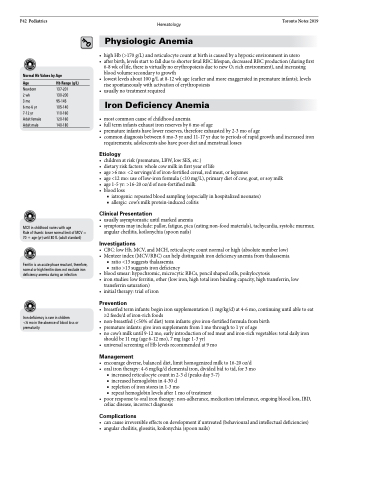Page 1076 - TNFlipTest
P. 1076
P42 Pediatrics
Normal Hb Values by Age
Hematology Toronto Notes 2019 Physiologic Anemia
• highHb(>170g/L)andreticulocytecountatbirthiscausedbyahypoxicenvironmentinutero
• afterbirth,levelsstarttofallduetoshorterfetalRBClifespan,decreasedRBCproduction(duringfirst
6-8 wk of life, there is virtually no erythropoiesis due to new O2 rich environment), and increasing
blood volume secondary to growth
• lowestlevelsabout100g/Lat8-12wkage(earlierandmoreexaggeratedinprematureinfants);levels
rise spontaneously with activation of erythropoiesis • usuallynotreatmentrequired
Iron Deficiency Anemia
• most common cause of childhood anemia
• full term infants exhaust iron reserves by 6 mo of age
• prematureinfantshavelowerreserves,thereforeexhaustedby2-3moofage
• commondiagnosisbetween6mo-3yrand11-17yrduetoperiodsofrapidgrowthandincreasediron
requirements; adolescents also have poor diet and menstrual losses
Etiology
• childrenatrisk(premature,LBW,lowSES,etc.)
• dietaryriskfactors:wholecowmilkinfirstyearoflife
• age>6mo:<2servings/dofiron-fortifiedcereal,redmeat,orlegumes
• age<12mo:useoflow-ironformula(<10mg/L),primarydietofcow,goat,orsoymilk • age1-5yr:>16-20oz/dofnon-fortifiedmilk
• bloodloss
■ iatrogenic: repeated blood sampling (especially in hospitalized neonates) ■ allergic: cow’s milk protein-induced colitis
Clinical Presentation
• usuallyasymptomaticuntilmarkedanemia
• symptomsmayinclude:pallor,fatigue,pica(eatingnon-foodmaterials),tachycardia,systolicmurmur,
angular cheilitis, koilonychia (spoon nails)
Investigations
• CBC:lowHb,MCV,andMCH,reticulocytecountnormalorhigh(absolutenumberlow) • Mentzerindex(MCV/RBC)canhelpdistinguishirondeficiencyanemiafromthalassemia
■ ratio <13 suggests thalassemia
■ ratio >13 suggests iron deficiency
• blood smear: hypochromic, microcytic RBCs, pencil shaped cells, poikylocytosis
• ironstudies:lowferritin,other(lowiron,hightotalironbindingcapacity,hightransferrin,low
transferrin saturation)
• initialtherapy:trialofiron
Prevention
• breastfedterminfants:beginironsupplementation(1mg/kg/d)at4-6mo,continuinguntilabletoeat ≥2 feeds/d of iron-rich foods
• non-breastfed(<50%ofdiet)terminfants:giveiron-fortifiedformulafrombirth
• premature infants: give iron supplements from 1 mo through to 1 yr of age
• nocow’smilkuntil9-12mo,earlyintroductionofredmeatandiron-richvegetables:totaldailyiron
should be 11 mg (age 6-12 mo), 7 mg (age 1-3 yr)
• universalscreeningofHblevelsrecommendedat9mo
Management
• encouragediverse,balanceddiet,limithomogenizedmilkto16-20oz/d
• oralirontherapy:4-6mg/kg/delementaliron,dividedbidtotid,for3mo
■ increased reticulocyte count in 2-3 d (peaks day 5-7) ■ increased hemoglobin in 4-30 d
■ repletion of iron stores in 1-3 mo
■ repeat hemoglobin levels after 1 mo of treatment
• poorresponsetooralirontherapy:non-adherance,medicationintolerance,ongoingbloodloss,IBD, celiac disease, incorrect diagnosis
Complications
• cancauseirreversibleeffectsondevelopmentifuntreated(behaviouralandintellectualdeficiencies) • angularcheilitis,glossitis,koilonychia(spoonnails)
Age
Newborn 2wk
3mo
6 mo-6 yr 7-12 yr Adult female Adult male
Hb Range (g/L)
137-201 130-200 95-145 105-140 110-160 120-160 140-180
MCV in childhood varies with age
Rule of thumb: lower normal limit of MCV = 70 + age (yr) until 80 fL (adult standard)
Ferritin is an acute phase reactant, therefore, normal or high ferritin does not exclude iron deficiency anemia during an infection
Iron deficiency is rare in children
<6 mo in the absence of blood loss or prematurity


